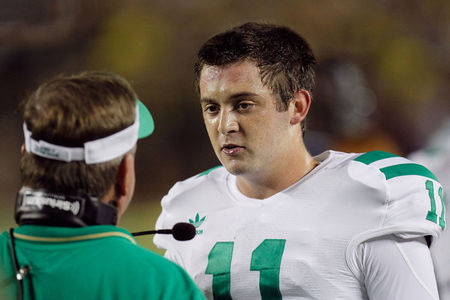Tommy Rees’ legal issues this off season have drastically increased the chances that Notre Dame will have a first-time starter under center in Dublin. While the thought of Andrew Hendrix or Everett Golson starting at quarterback have most Irish fans salivating, neither one has a fraction of Rees’ game experience. Hendrix and Golson have all the physical tools to take the offense to new heights, but fans will need to be prepared for some growing pains should either one win the starting role.
To limit the inevitable growing pains, the coaching staff must design game plans that put QB1 in the best position to succeed, i.e., avoiding obvious passing downs. Outside of a strong running game, one of the best ways to help QB1 succeed is by calling plays with simple route concepts and easy throws. An example of a simple route concept is the stick/flat combination. It’s probably used in some fashion by every team from high school to the NFL and is excellent on early downs to stay ahead of the chains.
Chris Brown at Smart Football has written extensively on the stick/flat route combination also known as the “two-man” concept. The “two-man” concept attacks a defense horizontally. One receiver pushes up field five to six yards and looks for a crease between defenders while a second receiver runs out to the flat. The quarterback reads the flat defender. If the flat defender widens, the stick should be open. If the flat defender drops back into coverage, the flat should be open.
Although the “two-man” concept can be run from a variety of formations and personnel groupings, Brian Kelly frequently uses the “two-man” concept in short yardage situations from a bunch formation. Below is an example of the Irish using the “two-man” concept in the red zone against Western Michigan in 2010.
On fourth and goal from the two, Kelly calls a play with a “two-man” concept to either side. On this particular play, the outside receivers will run five-yard stick routes, and the inside receivers will run to the flats.
If the defense plays zone, the play will horizontally stretch the flat defender leaving either Michael Floyd or Mike Ragone open. If the defense plays man, Floyd’s stick route should “pick” the defender lined up over Ragone.
Here, both defenders head toward the flat leaving Floyd wide open. It’s an easy read and throw for Dayne Crist. The defense has no chance of recovering.
Strike up the Victory Clog.
While it’s difficult to predict if the Irish will use the “two-man” concept with any frequency next season, it’s encouraging that notes from the Notre Dame Football Coaches Clinic suggest that the offensive staff will be packaging run and pass plays together in a single play. Below is a diagram of the increasingly popular stick/draw combo.
Like the “two-man” game, the stick/draw combo’s beauty is its simplicity. The quarterback initially looks to see if the tight end is open on the stick route. If the linebacker drifts over to cover the tight end, the quarterback hands off to the running back on the draw.
Based on the notes from the coaches clinic, it also appears Notre Dame will couple the stick with a shovel pass or even a quarterback draw. Below is a diagram of the stick combined with the quarterback draw.
When the stick is combined with the quarterback draw, it eliminates the timing issues on the handoff. Without having to worry about the exchange with the running back, the quarterback could make multiple reads before taking off. Can you imagine the possibilities for Hendrix or Golson? Perhaps we’ll find out in Dublin.
Add The Sports Daily to your Google News Feed!
